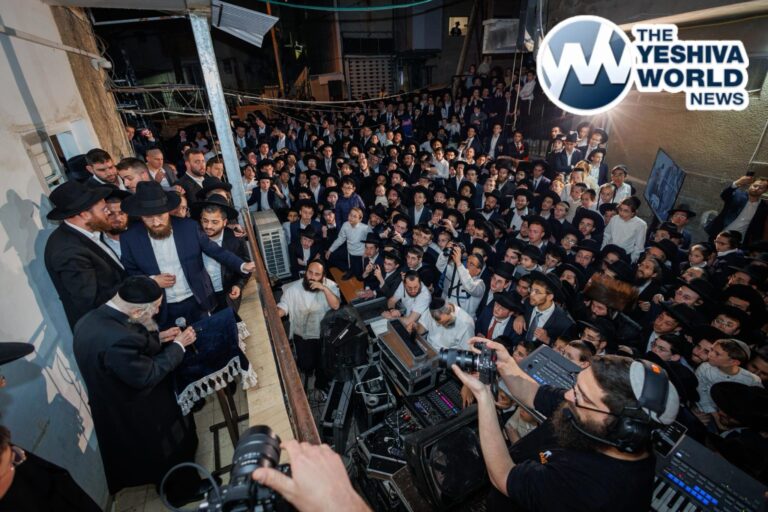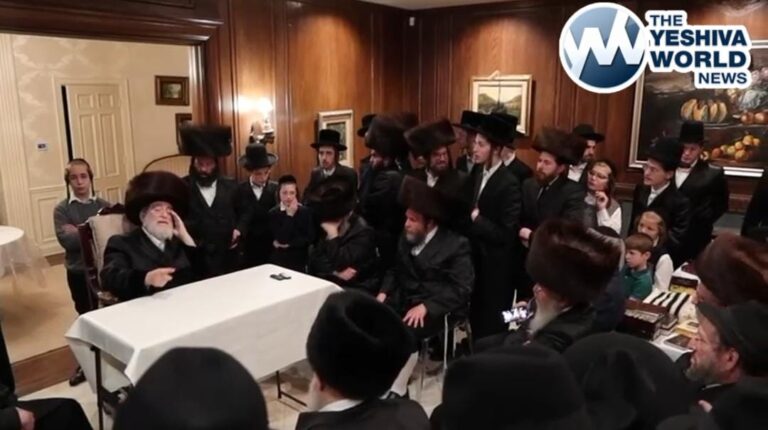We need to talk about Ka’eileh.
I know people like it, it’s fun. It’s the highlight of the Torah reading. But it isn’t benign–and I’m not talking about whether it’s a bizayon or if it’s fantastic because it makes people enjoy shul. I’m talking about something more serious and longer term.
Allow me to explain. Judaism in every generation rests on the foundation of the generations that came before–and especially on the one that comes immediately before. This is true even in the text-based world in which we currently live. Despite the unchanging nature of text, Judaism remains dynamic because the arguments and pesakim that we find in the Gemara, Rishonim, Acharonim, teshuvos, and halachic works are shaped by the way halacha is practiced and Judaism is lived in each and every generation. The old is viewed in light of the current. The strong trend in halacha to try, however much possible, to justify a widespread action halachically reflects this dynamism. While sometimes we cannot justify a custom, which forces us to reject it, our first choice is always to subsume it within the pre-existing halachic system. New halachic categories are created, prior concepts are expanded upon, and precedents are set. Old piskei halacha and positions are understood in new ways.
Why is this acceptable? Why are we ok with altering halacha based off of what people are doing? Shouldn’t halacha be pristine and untouched?
Yes and no. While fealty to halacha is paramount, we view common practice not as an external force but an internal halachic one. It is considered another way to determine the true halacha. Why? Firstly, we assume that widespread adoption of a custom signifies acceptance of it by the rabbinic authorities of the time in which it began/spread. Additionally, the gemara grants legitimacy to common custom to clarify unclear laws (Pesachim 66a) or to determine laws that depend on people’s perceptions (such as in regards to some kinyanim).
There is no doubt that this new practice has become widespread. Given its diametric opposition to the decorum we normally expect in shul and during krias hatorah, justifications will need to be given (and some already have been). And these new halachic ideas will function as precedents.
But does this practice rest upon the strong supports that we noted above? Does it deserve to force halachic modifications? I don’t think so.
Does “minhag ka’eileh”‘s widespread nature truly signify rabbinic acceptance? Unfortunately, in today’s world, making a general assumption like that about any new common practices wouldn’t be safe except in very specific communities. Regarding ka’eileh, the opposite is usually known to be true–it is usually viewed unfavorably even by those Rabbanim who feel they cannot directly confront it in their shuls. If a number of Rabbanim have come out in support of it, I’d be interested in hearing about it–I have generally heard it referred to only negatively.
Similarly, the halachic/hashkafic preference vis-a-vis decorum in shul and during krias hatorah is hardly unclear. The general preference of how to act during krias hatorah is well established in general and, up until a few years ago, for the word ka’eileh as well.
I know that there can be nice explanations for this new minhag. It can be presented with very real-sounding and inspiring vortlach. We can invent distinctions between types of congregational outbursts to explain why this one is acceptable while others are not, and so and so forth. But we know the truth–it is just a shtick that caught on…and that means these explanations aren’t true. They aren’t emes. If someone would have gotten up, given a beautiful drasha and argued that klal yisrael should take up this minhag and they enthusiastically did so, I could hardly protest. After all, it went through a halachic process; the halachic ramifications were consciously weighed at the outset and felt to be emes’dik. But adopting an after-the-fact explanation makes a mockery of the whole idea of mesorah and, down the line, of halacha and rigorous Judaism as well.
Lastly, I know that there are probably other common practices that have caught on in similar ways throughout our history. But that doesn’t change anything–Baruch Hashem, Judaism remains overwhelmingly coherent despite these failures on our part to preserve the mesorah. We certainly should do all we can to avoid further deterioration. Hashem controls the world, we can only do our part–and our part of preserving our mesorah is, well, to preserve our mesorah in the areas we can.
If you appreciate a consistency in halacha and the ability to extrapolate from one situation to another, if you appreciate comparing the use of certain words and terms in davening/tanach/gemara to form a comprehensive understanding of something, if you appreciate the ability to develop a cohesive hashkafic or halachic position or inspirational drasha then you appreciate logic and consistency. But that logic and consistency needs to be preserved and fought for–it doesn’t come lightly. Taking up non-halachic practices and then defining halacha in their light forces our halachic and hashkafic mesorah to say things it never did. It shatters Yahadus’ coherency by endorsing and shoehorning in explanations that are foreign to it.
I know ka’eileh is fun. I’m all for fun. But it can’t come at the expense of halacha, hashkafa, and our mesorah.
Please consider my words. Thank you for your time.
J. Ketler
The views expressed in this letter are those of the author and do not necessarily represent those of YWN. Have an opinion you would like to share? Send it to us for review.












32 Responses
The “Yiddishkeit” of today is based on shtick and leitzanus. It is superficial with no real long lasting impact in a spiritual sense. Don’t pass so quickly over the bizayon/letizanus element. It’s a bizayon HaTorah! This generation is all about “feel-good, connection, meaning” etc. We are no longer here to serve HaShem; HaShem is here to serve us.
What is this about? I have no idea. I watched a song by the same name and still have no idea. Whatever the writer is objecting to, I guess they don’t do it in my shul. In my community? On my planet?
There are worse things that you can complain about. For example when answering amen to the last bracha of shemonah esrei before Hallel very often that Amen ends up being an Amen chatufa. And how about on Yomim Noraim when the chazan is singing something during chazaras hashatz and everyone is drowning him out? Every word of chazaras hashatz needs to be heard. What you’re talking about is small compared to other issues
Absolutely correct, thank you for saying this.
Unfortunately, “ka’eileh” is just one symptom of the larger phenomenon of the stupidification of Yiddishkeit which is as pervasive as it is insidious.
We desperately need to recenter true Torah values and perspectives as our only lodestar.
No clue what this op-ed is talking about. What is the Ka’eileh minhag and why is it not good??
Some places act like jokers when this word is read and laugh and jump like nuts. The same guys who talk during davening and especially leining.
Thank you, well written. I’m all for silly videos and inane songs, but shtick during Kriahs HaTorah is unacceptable and wrong. It is a bizayon to what is most sacred to us. For the record, it does not happen in my shul. Period.
I agree with the poster, but according to their premise, we should stop people pointing at the Torah (especially with their pinky), as that’s also a new phenomenon people “started doing” and then it became recorded in halacha seforim. And no, don’t quote for me Me’am Loez, because the volume written on the end of Devorim was completed by a Rabbi in the 1950’s, and he was simply recording what he saw, which was that people point during hagbah. There’s no earlier source. Now it’s engraved in halacha, forever.
It’s Bizoyon Hatorah & kineged halachah. If you’re busy singing koaileh, you’re missing the kriah of the bal koreh & disturbing others from hearing the kriah.
I guess we’re running out of things to complain about. This on is reaching low in the barrel.
Maybe we need a new minhag in Klal Yisroel. Learn Kedushas Halevi daily. Learn how R Levi Yitzchok was Dan Yisroel Lkaf zechus and never to try to bend nature to find fault in Klal Yisroel.
Or as others have put it. Just get a job….
Finally, someone said something! Only problem is, it’s online and not in shul.
I’ve been wondering if this silliness has spread all around or if it was just my area/community.
If everyone would just control themselves for 6 months this thing would be over.
Nicely put. Ever notice that it’s the “Leytzanim” in Shul who are usually the loudest with this disruption?
I agree with the Mr. Ketler.
In yeshivishe shuls, this is not at all a problem. I attend two shuls. In the one that is a shul of bnei yeshiva, not a single person in the packed shul says ka’eile during leining. In the shul which is less yeshivish, the majority of the shul says it with the ba’al korei.
So no, this is not an issue that all of klal yisroel is dealing with.
Maybe first get rid of the Toameha craze
Well said. Thank you.
Somehow I don’t think this ranks as klal Yisroel’s big issues right now. I think there are more important things to worry about right now
Can someone please explain this minhag/hahahgah to me?
What in the world is “minhag ka’eileh?” They don’t do this in my shul. I have no idea what it is. Someone please explain.
I don’t know what you are complaining about and I don’t think you know either. You just sound upset about the davening taking too long cuz it’s chol hamoed and you’re tired of davening because of yom tov or you needed a better coffee but you are machmir to only get the cheap nescafe as if it’s your minhag but really it was on sale 7 minutes before yom tov. You care about shul but come in all salty with halacha. Tell me if you followed all other halachas this morning!? Go back to sleep till after yom tov and eat your chometz and then post a mailbox to thousands of people.
exactly, its a shtick that caught on because people find it fun, no one is claiming its an actual minhag or even has any meaning whatsoever (not including a certain singer), the thing im having trouble understanding is why you care, let people do meaningless things if they want to, you havent identified a single legitimate halachic reason against it, why dont you fulfill your chiyuv of saving the world by complaining about talking during davening, klal yisrael has much bigger problems than kaeileh
Can someone please explain what ka’eileh is for someone unfamiliar?
“The Sky Is Falling”
-Chicken Little
The “memeologist” (iykyk) posted a meme that the גמטריא of כאלה is the same as נו (Nu)
Seriously??? This is what’s bothering you? This is what “we” need to talk about? There are so many far more important issues on Klal Yisroel’s plate. This is a basically benign matter—something I don’t personally care for much either—but in the bigger picture, it’s just not that significant. And by the way, it’s not even new. It’s been going on for at least 40 or 50 years—probably much longer. Every shul has people who enjoy this kind of thing and similar activities. It gives them chiyus and simchas Yom Tov—why take that away from them? Also, many of these so-called “ka’eileh people” are major supporters of our shuls and mosdos hachinuch. At Seudah Shlishis, we say “Eileh v’ka’eila yosef imanu”—we need all Yidden, even the “ka’eileh people.”
As I understand, there may be a halachic basis for this minhag, actually.
https://www.sefaria.org/Sha'arei_Ephraim.8.24?lang=bi&with=all&lang2=en
What is ka’eilah?? Please explain.
The chutzpah to even remotely elevate this laitzanus to that of a minhag. Once again, it shows how low the frum community has sunk despite learning daf yomi. There is perhaps learning of Torah out there but virtually NO yiras shamayim. That begs the question: what is the value of learning if not accompanied by yiras shamayim? Anyone with a reply?
Wow these letters work!
Yesterday the baal korei had to repeat the word because it was so loud when the tzibbur did it for him the first time, but today – at the same minyan, I didn’t hear anyone else besides the baal korei say it!
For those who haven’t witnessed this minhag, its when the Chazzan gets to Keilah by the 4th Aliyah, a lot of people say it outloud with the Chazzan. KUHHHHEEEEEEYYYYYLEEEEEEEHHHHH…
I personally would package it next to when a Sefaradi says Kaddish, a lot of people automatically go “revech” outloud with him.
These all seem like brainless automatic things that at least keep people paying attention. Whether it stems onward to Bezayon…. I dont know, these are places where I think its actually the minhag.
In klal Yisroel there are two goups of yidden. No, not chassidim and misnagdim! Rather, the groups are: To say or not to say! One group of yidden that MUST say ka’eilah, and the other group of yidden cannot tolerate the saying of ka’eilah. Each group cannot understand the other group. Each group thinks its derech is the ONLY derech and the other is wrong. Eilu v’elu, like chassidim and misnagdim, klal yisroel is colorful and vibrant. Be tolerant. Be accepting. Maybe the author’s daughter will marry a ka’eilah yid!
Baal Koreh*
wisesage- maybe that should tell you something (or a whole lot of things) about daf yomi